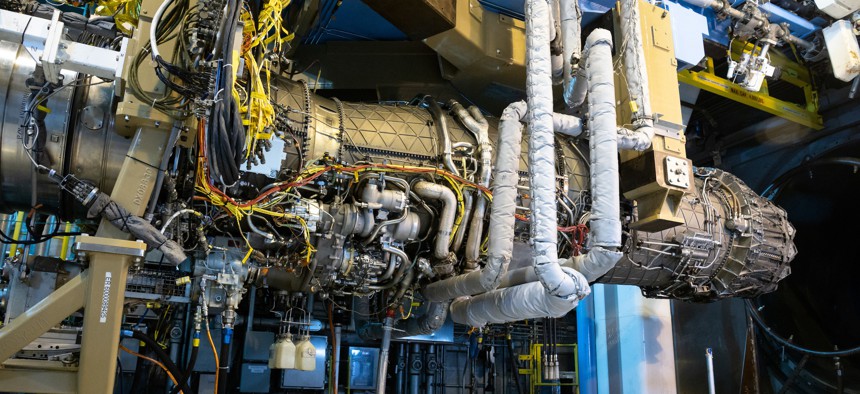
A Pratt & Whitney F135 engine hangs in Arnold Engineering Development Complex (AEDC) Sea Level Test Cell 3 at Arnold Air Force Base, Tenn., between test runs Sept. 2, 2021. U.S. Air Force / Jill Pickett
Air Force Abandons New F-35 Engine in Favor of Upgrades
If approved by Congress, it’s a win for F-35 engine maker Pratt & Whitney and a blow to General Electric.
Updated: 2:47 p.m. on March 13.
The Air Force is ditching its plans to develop a new engine for its F-35 fleet and will instead upgrade the existing Pratt & Whitney engines so the planes have enough power to use future weapons.
The decision to abandon the engine project, announced on Monday as part of the Air Force’s 2024 budget request, came down to cost, Air Force Secretary Frank Kendall said.
“We were not able to fund the AETP,” or Adaptive Engine Transition Program, Kendall said. “We needed something that was affordable, and that would support all the variants.”
Instead of holding a competition to build a brand-new engine, the Air Force will fund Pratt’s proposed “engine core upgrade”: improvements that will enable the existing F135 engine to generate more electricity and cooling for tomorrow’s weapons. The F-35A, the variant flown by the Air Force and most foreign customers, will get the improvements as part of its Block 4 upgrade.
The AETP program had paid General Electric and a Pratt-led team to develop engine concepts that could compete to become the next F-35 engine. General Electric said its XA100 adaptive engine, which began testing last year, would offer more thrust while burning less fuel.
Kendall has said building a brand-new engine would cost more than $6 billion, which would force the Air Force to buy fewer F-35s.
But when it came down to it, affordability wasn’t the only sticking point, Kendall said. The Air Force was the only service “seriously interested” in the adaptive engine, he said, noting that it would have been “very difficult, if not impossible” to put it on the Marine Corps’ F-35B variant, which has a large lift fan that enables the aircraft to take off from very short runways and land vertically.
If the cost of an adaptive engine was lower, it’s possible the Air Force would have included it in its budget request, but “we couldn’t get there,” Kendall told reporters on Friday ahead of the budget rollout. The service wants to spend $254 million in 2024 for the engine upgrade program.
The decision means Pratt, a subsidiary of Raytheon Technologies, can count on decades of sustainment contracts. In October 2021, Raytheon CEO Greg Hayes said he doubted the Air Force had enough money to buy an entirely new engine.
In response to the decision, GE said that this budget request “fails” to consider the need for “revolutionary capabilities that only the XA100 engine can provide by 2028.”
Congress has already spent over $4 billion on AETP, which will be “wasted” if the program ends so close to completion, a GE spokesperson said in a statement to Defense One.
“Nearly 50 bipartisan members of Congress wrote in support of advanced engine programs like ours because they recognize these needs, in addition to the role competition can play in reducing past cost overruns,” the spokesperson said.
An incremental upgrade to the current F135 engines “would still cost billions,” without providing the same capability improvements as the adaptive engine, the spokesperson said.
However, the technology Pratt and GE developed in AETP will lay the groundwork for the Next Generation Adaptive Propulsion program, or NGAP, which is expected to power the service’s next fighter jets, part of the Next-Generation Air Dominance effort, Kendall said.
The Air Force is requesting 48 F-35As in its fiscal 2024 budget request, five more jets than Congress approved last year. Kendall said the Air Force plans to buy a total of 1,763 F-35s.
“As you go over the five-year plan, we stay at that level”—48 jets per year—”basically for F-35s,” he said.




